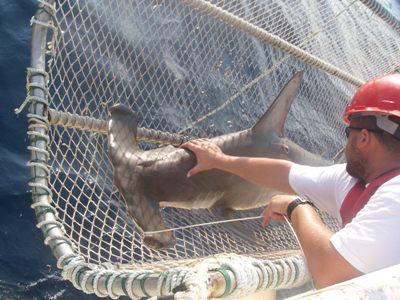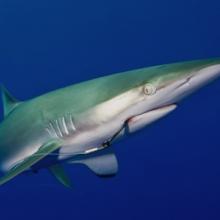
The National Marine Fisheries Service (NMFS) determined that the scalloped hammerhead shark (Sphyrna lewini), an Atlantic highly migratory species (HMS), is overfished (NOAA 04/28/2011). This finding is based on a stock assessment of the population in US Atlantic waters published by Hayes et al (2009) in the North American Journal of Fisheries Management. His study, completed in 2005, found that the stock of scalloped hammerheads had been depleted by 83% of its historic size.
This decline in the US population mirrors the decline of scalloped hammerheads globally. The IUCN (International Union for the Conservation of Nature) listed the Northwest and Central Atlantic population of scalloped hammerheads as Endangered with a decreasing population in 2006. Scalloped hammerheads have declined, in part, because they are targeted in global fisheries for their valuable fins, which are sold for shark fin soup. The other serious threat to scalloped hammerhead populations is bycatch.
Like many sharks, scalloped hammerheads have a high risk of overexploitation due to their late age at maturity, small reproductive output, and long lifespan. Unlike most other sharks, scalloped hammerheads, as well as great and smooth hammerheads, form schools, which make them vulnerable to being caught in high numbers by longlines, trawls, purse seines, and gillnets in both commercial and recreational fisheries. Unfortunately, high catch rates can mask the reality of a depleted population. In the US, the scalloped hammerhead is commonly caught in coastal bottom and pelagic longline fisheries, where it suffers from high hook mortality. Hammerhead sharks are ram ventilators, which means they have to constantly force water over their gills by swimming to get oxygen. Being hooked on a longline prevents oxygen intake in ram ventilating sharks and causes suffocation. Scalloped hammerhead sharks have a very high, 91.4%, rate of at-vessel mortality (meaning they are dead when they are brought on board the vessel). This makes management measures such as quotas and prohibition of retention unsuccessful, because they assume that the shark will be returned to the water alive.
In the US, eleven large coastal shark species, which includes hammerheads, have been managed as one large group. This is a problematic management technique because a decline in abundance in one species can be hidden by an increase in abundance of other species. Despite declines in the scalloped hammerhead population, a 2006 assessment of the large coastal sharks found that the group was not overfished. This problem highlights the need for species specific assessments.
The National Marine Fisheries Service must now take action to end or prevent continued overfishing and implement conservation measures to rebuild the scalloped hammerhead stock within two years.
Hayes, CG, Y Jiao, and E Cortes. 2009. Assessment of scalloped hammerheads in the western North Atlantic Ocean and Gulf of Mexico. North American Journal of Fisheries Management 29(5): 1407-1417.
Morgan, A and GH Burgess. 2007. At-vessel fishing mortality for six species of sharks caught in the Northwest Atlantic and Gulf of Mexico. Gulf and Caribbean Research 19(2): 1-7.
Image: NOAA
Featured Bycatch Species

The dusky shark is currently listed as Vulnerable by the IUCN, but populations continue to decline.
